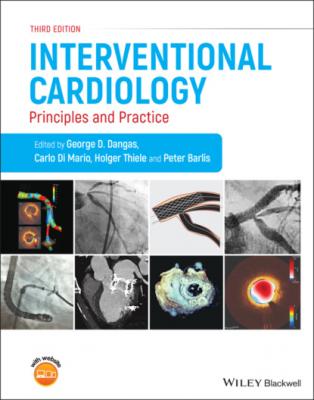Interventional Cardiology. Группа авторов
Читать онлайн.| Название | Interventional Cardiology |
|---|---|
| Автор произведения | Группа авторов |
| Жанр | Медицина |
| Серия | |
| Издательство | Медицина |
| Год выпуска | 0 |
| isbn | 9781119697381 |
Complications and management
Major vascular complications occur in 0.2% of radial procedures and major bleeding in 1.0% [32]. As with all procedures, complications can often be prevented with careful technique and experience (Table 3.2).
Table 3.2 Complications of transradial access.
| Intra‐procedural | Post‐procedural |
|---|---|
| Radial artery perforation | Radial artery occlusion (typically clinically silent) |
| Radial artery spasm | Hematoma +/‐ compartment syndrome |
| Catheter entrapment | Pseudoaneurysm |
| Arterial dissection | Atheroembolism/thromboembolism |
Spasm
The radial artery is a muscular vessel with abundant α‐adreno‐receptors located in the adventitia. The mean size of the proximal radial artery is 2.55mm ± 0.39 and is marginally bigger than the distal radial artery in the anatomical snuffbox (2.34mm ± 0.36, difference 0.2 ± 0.16mm; p < 0.001) (33). With limited vessel clearance, catheter advancement can induce local trauma with resultant vasospasm and arm pain. Any further catheter manipulation without remedial action will exacerbate the problem and lead to access‐site crossover. Radial artery spasm (Figure 3.1d) occurs in roughly 15% of procedures with several predictive risk factors including female sex, higher radial artery takeoff, smaller artery diameter, larger cathetersize, increased number of punctures and pain response during cannulation [34].
With increased operator experience and the development of hydrophilic catheters, the incidence of vasospasm has reduced [35]. Preventative measures that vasodilate the artery and limit arm pain can be employed to lower the risk of spasm. Intra‐arterial lignocaine injection can induce vasospasm and should be avoided [36]. Administration of a “radial cocktail” of anti‐spasmodic drugs via the arterial sheath should be routinely administered [37]. Both glyceryl trinitrate (0.1–0.4 mg) and verapamil (2.5–5 mg) have a strong evidence base in preventing spasm without significant hemodynamic consequences [38]. We prefer heparin (2000–5000 IU) administration into the aorta rather than via the radial sheath given that it is painful and potentially mediates spasm while simplifying a TFA approach should this be necessary. Adequate sedation/analgesia also play an important role in reducing failure of TRA [39].
Hematoma
Hematomas occur in <5% of TRA cases and rarely require imaging or blood transfusions (unlike those associated with femoral access). Typically, they are caused by guidewire‐ or catheter‐induced damage to small arterial branches proximal to the puncture site (Figure 3.3d and e). Bertrand’s Early Discharge After Transradial Stenting of Coronary Arteries (EASY) hematoma scale (<link href="urn:x-wiley:9781119697343:xml-component:w9781119697343c3:c3-fig-0004">Figure 3.4</link>) is helpful for sizing hematoma associated with traditional proximal radial access (<link href="urn:x-wiley:9781119697343:xml-component:w9781119697343c3:c3-fig-0004">Figure 3.4</link>). Grade I, ≤5 cm (local hematoma, superficial); grade II, ≤10 cm (hematoma with moderate muscular infiltration); grade III, >10 cm below the elbow (forearm hematoma and muscular infiltration); grade IV, hematoma extending above the elbow and grade V, compartment syndrome [40,41]. Early detection is key to preventing progression to a major complication such as compartment syndrome [42]. Pressure bandaging, withholding anti‐coagulating medications and inflation of a blood pressure cuff immediately proximal to the hematoma to 20 mmHg below systolic blood pressure for 15 minutes is usually sufficient to manage larger hematomas (Figure 3.3d).
Figure 3.3 Complications of Transradial Access. (a) Radial perforation caused by a hydrophilic 0.035" (Benson) wire. (b) Subclavian artery spiral dissection caused by 0.035 in J‐wire in a patient with marked subclavian tortuousity. (c) Catheter kinking and entrapment (retrieved via the same access site in this case after unwinding and wiring with 0.035" wire). (d) Illustration of forearm hematoma compression. Note the forearm hematoma is proximal and distinct from puncture site at the distal radial artery. This likely resulted from wire or catheter induced damaged to small arterial branches proximal to the puncture site. The manual sphygmomanometer is inflated 15–20 mmHg above systolic blood pressure for 5–10 minutes before a repeat clinical examination of the site. (e) Grade IV hematoma complicating proximal TRA PCI for myocardial infarction in a 94‐year‐old woman with severe chest pain and hypertension. The patient developed a pseudoaneurysm that ruptured during ultrasound examination the following day. The image illustrates her two large skin tears where her skin separated during compression hemostasis of the ruptured vessel. This lady was observed for compartment syndrome and went on to make a full recovery without any surgical intervention. The pseudoaneurysm was treated using ultrasound targeted compression after the skin wounds had healed.
Figure 3.4 Transradial hematoma classification system (From Bertrand et al., Catheter Cardiovasc Interv 75:366–368; 2010. Reproduced with permission of John Wiley & Sons.)
Compartment syndrome
Compartment syndrome caused by bleeding into a forearm compartment is a limb‐threatening emergency that is fortunately exceedingly rare (incidence of 0.004%) [43]. Beyond the above measures to treat large hematomas, early involvement of an experienced hand surgeon that can perform a fasciotomy is recommended to prevent an ischemic limb.
Radial or brachial artery perforation
